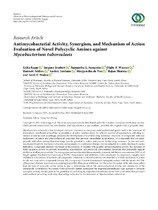| dc.description.abstract | Mycobacterium tuberculosis has developed extensive resistance to numerous antimycobacterial agents used in the treatment of tuberculosis. Insufficient intracellular accumulation of active moieties allows for selective survival of mycobacteria with drug resistance mutations and accordingly promotes the development of microbial drug resistance. Discovery of compounds with new mechanisms of action and physicochemical properties that promote intracellular accumulation, or compounds that act synergistically with other antimycobacterial drugs, has the potential to reduce and prevent further drug resistance. To this end, antimycobacterial activity, mechanism of action, and synergism in combination therapy were investigated for a series of polycyclic amine derivatives. Compound selection was based on the presence of moieties with possible antimycobacterial activity, the inclusion of bulky lipophilic carriers to promote intracellular accumulation, and previously demonstrated bioactivity that potentially support inhibition of efflux pump activity. The most potent antimycobacterial demonstrated a minimum inhibitory concentration (MIC99) of 9.6 μM against Mycobacterium tuberculosis H37Rv. Genotoxicity and inhibition of the cytochrome bc1 respiratory complex were excluded as mechanisms of action for all compounds. Inhibition of cell wall synthesis was identified as a likely mechanism of action for the two most active compounds (14 and 15). Compounds 5 and 6 demonstrated synergistic activity with the known Rv1258c efflux pump substrate, spectinomycin, pointing to possible efflux pump inhibition. For this series, the nature of the side chain, rather than the type of polycyclic carrier, seems to play a determining role in the antimycobacterial activity and cytotoxicity of the compounds. Contrariwise, the nature of the polycyclic carrier, particularly the azapentacycloundecane cage, appears to promote synergistic activity. Results point to the possibility of combining an azapentacycloundecane carrier with a side chain that promotes antimycobacterial activity to develop dual acting molecules for the treatment of Mycobacterium tuberculosis. | en_US |

